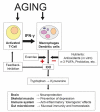Physical Activity and Diet Shape the Immune System during Aging
- PMID: 32121049
- PMCID: PMC7146449
- DOI: 10.3390/nu12030622
Physical Activity and Diet Shape the Immune System during Aging
Abstract
With increasing age, the immune system undergoes a remodeling process, termed immunosenescence, which is accompanied by considerable shifts in leukocyte subpopulations and a decline in various immune cell functions. Clinically, immunosenescence is characterized by increased susceptibility to infections, a more frequent reactivation of latent viruses, decreased vaccine efficacy, and an increased prevalence of autoimmunity and cancer. Physiologically, the immune system has some adaptive strategies to cope with aging, while in some settings, maladaptive responses aggravate the speed of aging and morbidity. While a lack of physical activity, decreased muscle mass, and poor nutritional status facilitate immunosenescence and inflammaging, lifestyle factors such as exercise and dietary habits affect immune aging positively. This review will discuss the relevance and mechanisms of immunoprotection through physical activity and specific exercise interventions. In the second part, we will focus on the effect of dietary interventions through the supplementation of the essential amino acid tryptophan, n-3 polyunsaturated fatty acids, and probiotics (with a special focus on the kynurenine pathway).
Keywords: aging; exercise; immunosenescence; inflammaging; kynurenine pathway; nutrition.
Conflict of interest statement
The authors declare no conflict of interest.
Figures


References
-
- Batatinha H.A.P., Rosa Neto J.C., Krüger K. Inflammatory features of obesity and smoke exposure and the immunologic effects of exercise. Exerc. Immunol. Rev. 2019;25:96–111. - PubMed

